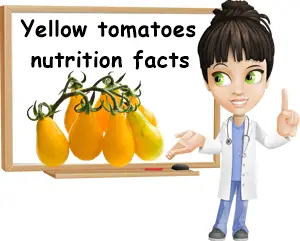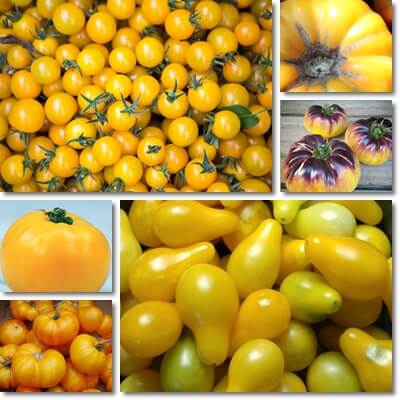If you’ve never been very keen on regular red tomatoes, then yellow tomatoes might just be the tomato for you to try. Versus red tomatoes, yellow tomatoes have a plainer flavor profile with a straight sweet taste and are generally less acidic.
While some nutritional aspects do change between yellow and red tomatoes, it’s not actually a bad thing.
On the contrary, yellow tomatoes are high in pigmented xanthophyll antioxidants which are a source of important benefits for eyesight, promoting the physical health of the eyes. In terms of nutrition, yellow tomatoes are a good source of vitamins C, B1, B3, B6 and B9, magnesium and potassium, and low in calories.

What are yellow tomatoes?
Yellow tomatoes are a yellow-colored type of tomato. They are the exact same species as regular red tomatoes, just a different color. Botanically speaking, yellow tomatoes are a fruit, a berry to be more exact, but a culinary vegetable. What makes them yellow instead of red is a class of organic yellow pigments called xanthophylls (e.g. lutein, zeaxanthin).
The pigments develop naturally in yellow tomatoes, presumably as a natural mutation that occurred early in the fruit’s history. In fact, yellow tomatoes are documented to have been brought to Europe from South America as early as the 1500s. Unlike yellow tomatoes which occurred naturally, blue tomatoes as well as black tomatoes are genetically modified.
What do yellow tomatoes look like?
Yellow tomatoes come in many forms and sizes and almost as many varieties as red ones. There are yellow cherry tomatoes and yellow grape tomatoes, with special varieties such as round yellow baby tomatoes and pear-shaped yellow pear tomatoes.
There are regular size, perfectly round yellow tomatoes and large ribbed beef varieties such as the yellow Beefsteak tomatoes. The skin is thin, glossy and smooth, and ranges in color from pale yellow to golden yellow to yellow-orange.
The flesh is soft, but firm and the juice pale yellow to colorless. Special varieties such as yellow and red or yellow and orange-striped tomatoes or yellow tomatoes with purple or blue shoulders also exist (see pictures below).
Note: Yellow tomatoes are not just unripe red tomatoes. They are an entirely different variety from red and are perfectly ripe when they are a uniform yellow color.
But both yellow and red tomatoes start out green when unripe and turn yellow and red, respectively, when ripe. Find out more about what are yellow tomatoes.

What do yellow tomatoes taste like?
Do yellow tomatoes taste very different from red? While still the same botanical fruit, yellow tomatoes taste somewhat different from red. More exactly, they taste outright sweet and have an overall plainer flavor profile, without the savoriness of red tomatoes. Except for some varieties and fruit that are unripe, yellow tomatoes are not usually acidic like red (assuming they are ripe and have enjoyed the best growing conditions).
Yellow tomatoes nutrition
Yellow tomatoes stand out as a good source of nutrition and are an extremely low-calorie food, low in fat, protein as well as carbohydrates and sugar. Yellow tomatoes are a good source of vitamin C, vitamins B1, B3, B6 and B9, magnesium, potassium, copper. They are low in vitamin E and have virtually no vitamin A, no vitamin D and no vitamin K. Yellow tomatoes contain modest amounts of calcium, iron, manganese, phosphorus and trace amounts of selenium.
Yellow tomatoes nutrition facts per 100 grams:
- Energetic value: 15 kcal (kilocalories, calories)
- Fat: 0.3 grams
- Protein: 1 gram
- Carbohydrates: 3 grams
- Dietary fiber: 0.7 grams
Vitamins in yellow tomatoes:
- Vitamin A: 0 mcg (micrograms)
- Vitamin B1: 0.04 mg (milligrams)
- Vitamin B2: 0.047 mg
- Vitamin B3: 1.179 mg
- Vitamin B5: 0.11 mg
- Vitamin B6: 0.056 mg
- Vitamin B9: 30 mcg (micrograms)
- Vitamin B12: 0 mcg
- Vitamin C: 9 mg
- Vitamin D: 0 mcg
- Vitamin E: 0.5 mg
- Vitamin K: 2.1 mcg (micrograms)
Minerals in yellow tomatoes:
- Calcium: 11 mg (milligrams)
- Copper: 0.101 mg
- Iron: 0.49 mg
- Magnesium: 12 mg
- Manganese: 0.12 mg
- Phosphorus: 36 mg
- Potassium: 258 mg
- Selenium: 0.4 mcg
- Sodium: 23 mg
- Zinc: 0.28 mg
Source: USDA
What are the benefits Of Yellow Tomato? (13 Amazing Benefits)
Anticancer properties
While unripe and green, yellow tomatoes contain tomatine, a natural constituent with scientifically proven anticancer properties. Find out more about tomatoes as an anticancer food.
Good for the physical health of the eyes
Yellow tomatoes are high in lycopene and zeaxanthin, antioxidants which get absorbed in the retina and contribute to the physical health of the eyes. The antioxidants protect the retina from damage caused by sunlight radiation.
Help improve vision
Yellow tomatoes are a source of important benefits for vision including benefits for visual acuity, color vision and night vision. Not just this, but eating yellow tomatoes may help reduce risks of cataract and age related macular degeneration. The benefits stem from the pigmented antioxidants that make yellow tomatoes yellow.
Good for high blood pressure
Yellow tomatoes are very low-sodium and provide good amounts of potassium and magnesium, electrolytes that help counteract the side effects of sodium and actively lower blood pressure numbers.
They are a low GI food
Yellow tomatoes are a low glycemic index food, or low GI food. The glycemic index score of yellow tomatoes is 15 which is a very low value. What this means is that eating yellow tomatoes has minimal effects on blood sugar. Not just this, but they are a good food to eat with diabetes in reasonable amounts.
Benefits for diabetics
Eating yellow tomatoes is good for diabetes because it does not raise blood sugar levels excessively as well as provides biologically active micronutrients and antioxidants to protect against diabetes-associated tissue damage, include damage to the optic nerve and eyesight.
Minor benefits for teeth and gums
What makes yellow tomatoes good for teeth and gums is a good content of vitamin C. Vitamin C in the fruit stimulates the production of special types of collagen that build teeth and make them strong. Not just this, but vitamin C also strengthens the walls of capillaries, small blood vessels that vascularize gums, preventing bleeding gums and gum disease.
However, vitamin C is present intact only in the fresh tomatoes – cooking yellow tomatoes destroys their vitamin C content and along with it, its benefits. Discover what vitamins you need for teeth and bones.
Minor laxative effects
Eating yellow tomatoes is good for constipation relief thanks to the fruit having a high water and a good fiber content. While fiber adds bulk to stools, stimulating contractions of the muscles of the intestinal tract that move food along, water helps soften stools, improving their consistency.
Good for weight loss
Yellow tomatoes are very low in calories, almost free of fat and cholesterol free. They are not high in carbs or sugar either which makes them a good food to eat for a weight loss diet. Not only do yellow tomatoes help you achieve a calorie deficit needed for weight loss, but they also help keep you satiated with dietary fiber which helps prevent overeating.
Important source of antioxidants
Yellow tomatoes are rich in antioxidants, including vitamin C, organic yellow and colorless antioxidants. Antioxidants combat oxidative stress and limit and help repair cell and DNA damage caused by harmful free radical molecules.
Cholesterol lowering properties
Yellow tomatoes are good for high cholesterol. The colorful culinary vegetables owe their cholesterol lowering effects to a good content of vitamin B3 which helps lower LDL (bad) cholesterol and triglyceride levels, and raise HDL (good) cholesterol.
How much vitamin B3 in yellow tomatoes? A serving of just 100 grams provides an average of 7.4% of all the vitamin B3 the average adult needs in a day.
Combat weakness, tiredness and fatigue
Eating yellow tomatoes boosts energy levels and vitality via a good content of and varied B vitamin profile that includes good amounts of vitamins B1, B3, B6 and B9. Vitamins B6 and B9 in particular exert a revitalizing action and combat tiredness and fatigue. Vitamins B6 and B9 are needed to make red blood cells and boost the capacity of hemoglobin in red blood cells to bind to oxygen which translates into an energizing action and a boost in vitality.
Not just this, but the good amounts of vitamin C in fresh yellow tomatoes help the body absorb iron better which is good for anemia and associated symptoms such as malaise, muscle weakness, fatigue and low energy levels.
Benefits for pregnant women
With 7.5% of daily values of folate, yellow tomatoes help combat fatigue in pregnancy and contribute to the normal development of the baby in the womb, reducing risks of neural tube defects of the brain, spine and spinal cord.
